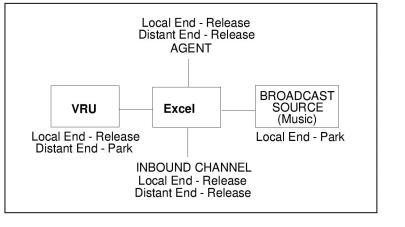
You are here: CSP Developerís Guide: Internet Protocols†>†2 VDAC-ONE Card †>†Release Mode Configuration

Release modes are managed by the Channel Management (CH) PPL component of CSP Call Control. When a connection is terminated, the local and distant-end release modes are used to determine what action to take on the released channels.
The terms local and distant are relative to the channel being configured. To specify whether a channel is released or parked when the other channel in a connection releases, you configure the channelís local-end release mode. To specify whether the other channel in the connection is released or parked when that channel releases, you configure the channelís distant-end release mode.
When a channel terminates a connection, the CSP refers first to the local-end release mode of the other end of the connection, and then to the distant-end release mode of the channel that initiated the release. If either end is set to park, the channel parks, otherwise, it is released. The host is informed of the state of a channel with either a Channel Released or a DS0 Status Change message.
When you configure a channel, use the distant-end release mode so that the distant end (the other channel in the connection) is not released when the connection is terminated. For example, you would not want to release an inbound channel that is connected to a Voice Response Unitís (VRU) Please Wait message before it is queued up for an available agent.
When the announcement is finished, the VRU channel is released for other calls and the inbound channel is parked. The distant-end release mode of the VRU channel is set to park so that when the VRU releases at the end of the message, all inbound channels connected to the VRU park.
When you are configuring a channel, use local-end release mode so that the channel is not released when a connection is terminated. Consider the previous example for distant-end release mode. To configure a source to broadcast music to the channels waiting for an agent, the local-end release mode of the broadcast channel is set to park. When no channels are connected to the broadcast channel, it parks until another channel is connected. In contrast, if you allow the channel to release, it must be outseized after each connection is broken down.
Release Mode Diagram illustrates the preceding examples. Both release modes for the inbound channel are set to release. Therefore, when the connection is torn down, it will be parked only if the distant-end release mode of the other channel is set to park (as is the case for the VRU and the Broadcast Source).
If the distant-end release mode of the other channel is set to release (as is the case with the agent channel) the inbound channel is released when the connection is torn down.
Figure 2-10 Release Mode Diagram

To configure Release Mode to either Park or Release, use the PPL Configure message to modify the PPL Config Bytes of the CH PPL component.
ē Local-End Release Mode - Config Byte 3
ē Distant-End Release Mode - Config Byte 4
You can also change release modes by using either the Local End Release Mode Configure or the Distant End Release Mode Configure message.